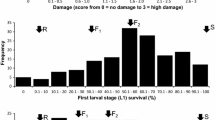Summary
A preliminary evaluation for resistance to chili thrips, Scirtothrips dorsalis Hood of 41 and 194 pepper (Capsicum annuum L.) germplasms during 1987 and 1988, respectively, indicated chili accessions may be a promising source of resistance. In contrast, all sweet pepper accessions tested were highly susceptible. A number of chili accessions produced a moderate yield, in spite of a high thrips infestation indicating tolerance to S. dorsalis. Rating for thrips damage was more reliable and efficient than estimating thrips numbers in screening pepper accessions for resistance to thrips. Highly significant, positive correlation between ratings at the seedling stage and final rating for thrips damage indicated the feasibility of screening pepper accessions at the seedling stage. Comparing the similarities in rating among accessions resulted in 40 distinct groups. The variance-covariance matrix of the data from these 40 groups was subjected to principal component analysis. This accounted for 56 and 18 per cent of the variation across the two principal axes, respectively. Projection of chili and sweet pepper accessions along these two axes revealed three distinct clusters. About 80 per cent of chili accessions formed the first cluster, 58 per cent of the sweet pepper accessions formed the second cluster and a third cluster exhibited intermediate ratings for thrips damage. The significance of these findings in relation to geographical divergence and resistance to thrips among pepper accessions is discussed.
Similar content being viewed by others
References
Amin, P.W., 1979. Leaf curl disease of chili peppers in Maharashtra, India. PANS. 25: 131–134.
Amin, P.W., D.V.R. Reddy, A.W. Ghanekar & M.S. Reddy, 1981. Transmission of tomato spotted wilt virus, causal agent of bud necrosis of peanut, by Scirtothrips dorsalis and Frankliniella schultzei. Plant Dis. 65: 663–665.
Anantha Krishnan, T.N., 1973. Thrips: Biology and control. Macmillan Company of India. Delhi press, Delhi, pp. 120.
Cho, J.J., R.F.L. Mau, R.W. Hartman, L.S. Yudin, D. Gonsalves & R. Provvidenti, 1989. A multidisciplinary approach for tomato spotted wilt virus (TSWV) management in Hawaii. Plant Dis. 73: 375–383.
David, P.M.M. & P. Natarajan, 1986. Evaluation of chili accessions tolerant to thrips Scirtothrips dorsalis Hood. South Indian Horticulture 34: 432–434.
Fery, R.L. & J.M. Schalk, 1991. Resistance in pepper (Capsicum annuum L.) to western flower thrips, Frankliniella occidentalis (Pergande). HortScience 26(8): 1073–1074.
Horber, E. 1980. Types and classification of resistance. In: F.G. Maxwell & P.R. Jennings (Ed.), Breeding plants resistant to insects. pp. 15–21. Wiley, New York.
Jagan Mohan, N., K. Krishnaiah & V.G. Prasad, 1980. Evaluation of insecticides for the control of pests of sweet pepper (Capsicum annuum var. grossum Linn). Pestology. 4: 1–4.
Lawley, D.N. & A.E. Maxwell, 1963. Factor analysis as a statistical method, Butterworths, London.
Lewis, T.R., 1973. Thrips. Their biology, ecology, and economic importance. Academic press, New York.
Pickersgill, B., 1971. Relationships between weedy and cultivated forms in some species of chili peppers (genus Capsicum). Evolution: 25: 683–691.
Pickersgill, B., 1989. Genetical resources of Capsicum for tropical regions. p. 1–9. Proc Int. Sym. on Integrated management Services: Tomato and pepper production in the tropics. AVRDC, Taipei.
Poulos, J.M., 1994. Pepper breeding (Capsicum spp.): achievements, challenges and possibilities. Plant Breeding Abstracts. 64: 143–155.
Rao, M. & K. Ahmed, 1986. Screening of chili germplasm for resistance to some important pests. Cocoa, Arecanut & Spices Journal. 9: 40–43.
Sanap, M.M. & R.N. Nawale, 1985. Reaction of chili cultivars to thrips and mites. J. Maharashtra agric. Univ. 10: 352–353.
Singh, J.H. & D.S. Cheema, 1989. Present status of tomato and pepper production in India. p. 452–471. Proc Int. Sym. on Integrated management Services: Tomato and pepper production in the tropics. AVRDC, Taipei.
Tewari, G.C., Deshpande, A.A. & N. Anand, 1985. Chili pepper genotype resistant to thrips (Scirtothrips dorsalis Hood). Capsicum Nwls. 4: 73–74.
Yoon, J.Y., Green, S.K., Tschanz, A.T., Tsou, S.C.S. & L.C. Chang, 1989. Pepper improvement in the tropics: Problems and the AVRDC approach. p. 86–98. Proc Int. Sym. on Integrated management Services: Tomato and pepper production in the tropics. AVRDC, Taipei.
Author information
Authors and Affiliations
Rights and permissions
About this article
Cite this article
Krishna Kumar, N.K., Aradya, M., Deshpande, A.A. et al. Initial screening of chili and sweet pepper germplasm for resistance to chili thrips, Scirtothrips dorsalis Hood. Euphytica 89, 319–324 (1996). https://doi.org/10.1007/BF00022288
Received:
Accepted:
Issue Date:
DOI: https://doi.org/10.1007/BF00022288




